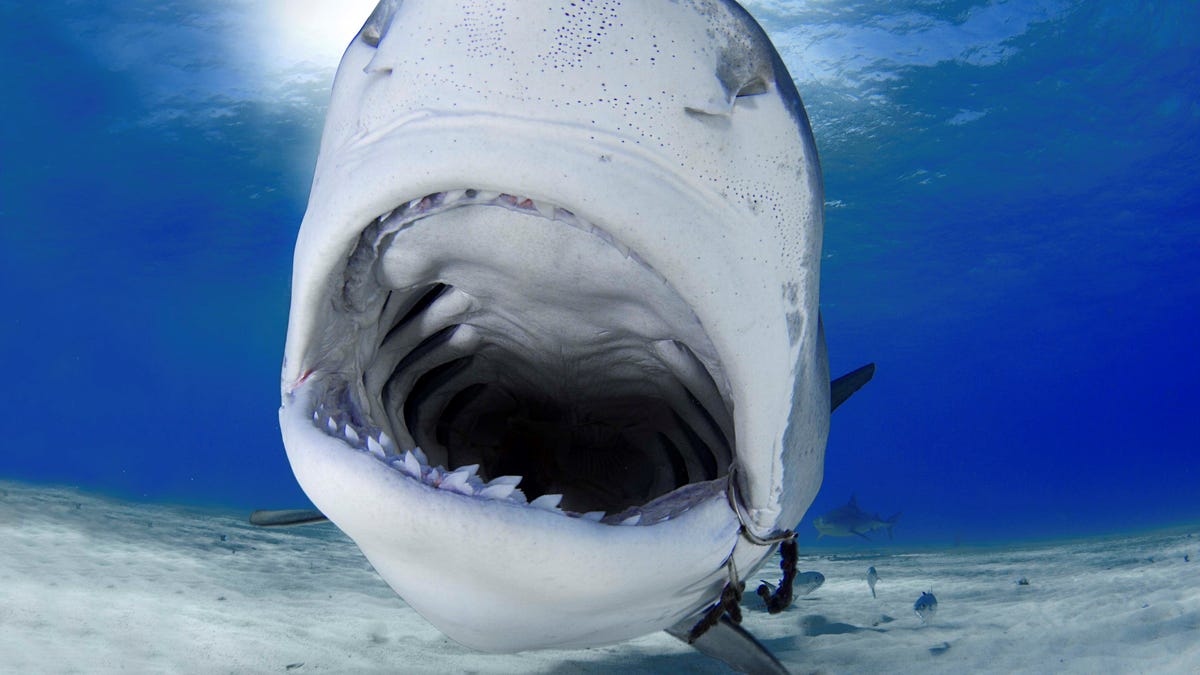The ocean’s most feared but fascinating predators face increasing dangers from the world’s warming oceans, scientists found in two international studies released this week.
Both studies revealed new information about sharks that surprised scientists and added to a growing body of research raising concerns about warming oceans and the effects of human activities on ocean ecosystems.
Large sharks, tunas and other predators make far more deep dives into the ocean than previously understood, concluded a study led by Camrin Braun, an assistant scientist at Woods Hole Oceanographic Institution. The study also found that disruptions to ocean ecosystems from climate change and mining – without careful consideration of the risks and benefits – could threaten species at the top of the ocean food chain, harming conservation efforts and commercial fishing.
The second study, based in Ireland, looked at the family lineage and biology of smalltooth sand tiger sharks, one of several species turning up more often in that region as the oceans warm.
Both studies add weight to growing concerns about the impacts of climate change on the world’s fish and fisheries and the need for better global and regional management, said Andrew Clayton, project director of international fisheries for The Pew Charitable Trusts.
“It’s going to require new approaches in ecosystem-based management, with long-term plans that respond to the signals from things like sea surface temperatures,” Clayton said.
Tracking the deep dives of sharks, tuna and swordfish
Scientists were surprised to find frequent deep diving among sharks and other large predators when they compared satellite tag data with acoustic data, in the Woods Hole study. That research, part of an ongoing project in the deep ocean with an international team of collaborators, was published Monday in the Proceedings of the National Academy of Sciences.
What researchers looked at:
- Information from 344 electronic tags on 12 large species, including white sharks, tiger sharks, whale sharks, yellowfin tuna and swordfish.
- More than 45,000 days in the lives of the fish.
- A 3D model comparing the diving information with acoustic data for the daily migration of fish, mollusks, crustaceans and other species from the ocean’s “twilight zone” during the day to surface waters at night to feed.
What they found:
- The sharks and other predators made a surprising number of visits to the “twilight zone.” Also called the mesopelagic zone, it’s roughly between 650 feet and 3,280 feet below the surface.
- Some fish had “really crazy deviations,” diving much deeper than expected, to depths of 3,000 or 6,000 feet, a depth known as the midnight zone for its low light conditions.
“No matter what top predator you look at, or where you look at them in the global ocean, they all spend time in the deep ocean,” Braun said. “All of these animals that we think of as being residents of the surface ocean, use the deep ocean way more than we previously thought.”
Although the research found the prey makes it worthwhile for predators to dive deep, even though they’re encountering little light, high pressure and near freezing temperatures, Braun said the fish could be diving for other reasons that aren’t yet fully understood.
Fishing in a warming world: Climb aboard four fishing boats with us to see how America’s waters are changing
Warmer water could threaten smalltooth sand tiger sharks
In April, a smalltooth sand tiger shark washed up on a beach on the Irish coast, something that had not happened before.
“We knew we had to go and investigate its anatomy given its position in the shark ‘family tree,’” said Nicholas Payne, director of the biodiversity and conservation program at Trinity College Dublin. Smalltooth sand tiger sharks are thought to have diverged from Megalodon sharks as much as 20 million years ago.
Their results feed into broader concerns about the plight of many shark species in the face of climate change and overfishing, Payne told USA TODAY.
What they found:
During a necropsy, the scientists found the sand tiger shark may share a similar trait with the white shark and the largest fish that ever lived on Earth – the prehistoric, extinct megalodon. That’s the ability to keep certain areas of their bodies warmer than the surrounding ocean, helping the sharks to be more powerful and athletic. Another recent study found that basking sharks have the same ability, called regional endothermy.
The findings mean it’s likely that several other sharks also are warm-bodied, which may put them at greater risk from warming seas, according to the study, published this week in the journal Biology Letters.
Scientists surmise that changing environments in the deep past were a major contributor to the megalodon’s extinction, because it couldn’t meet the energetic demands required, said Haley Dolton, the study’s lead author.
“We know the seas are warming at alarming rates again now and the smalltooth tiger that washed up in Ireland was the first one seen in these waters,” Dolton said. “That implies its range has shifted, potentially due to warming waters, so a few alarm bells are ringing.”
Climate change poses risks to ocean ecosystems and fishing
The deep diving study follows publication of an August study, also co-authored by Braun and others, that found the effects of the warming oceans can already be seen in the ocean habitats of several species of sharks and other highly migratory predators in the Atlantic Ocean off the U.S. Coast and the Gulf of Mexico. Both regions are among the fastest warming.
“Climate change is expected to fundamentally change the status quo for where these species are and how they live,” Braun said in August. The research concluded 12 species will encounter widespread loss of suitable habitat in those regions by end of century, in some cases by 70%. Among the fish species included in that August study were porbeagle, shortfin mako, five species of tuna, sailfish, marlin and swordfish.
Besides the expected climate-induced changes, additional impacts from an overlap in fishing efforts, predator distribution and deep sea mining could put critical ecosystems in jeopardy, the scientists concluded. Because such disruptions threaten species at the top of the food chain, harming conservation efforts and the economically important commercial fishing industry, researchers said it’s important to protect and continue learning more about the deep ocean.
The studies also illustrate the pressing need to finalize development of a global framework of regional fisheries management organizations, Clayton said.
The WHOI-led study emphasizes the need to be “precautionary,” not just about catching top predators, but also about leaving enough fish for the predators, he said. “It’s not good enough to manage a single species,”
For example, there’s been emerging research into commercially harvesting fish in the twilight zone, he said. “We’re often looking for the next fish to exploit without thinking about the predators that depend on those fish at that moment.”
If exploitation begins before scientists understand how the ecosystems work, “there’s a really big risk of causing damage that is not easily reversible,” said Alice Della Penna, a co-author and collaborator at the University of Auckland, New Zealand.
Rare video ‘Something different’: The courtship ritual of threatened sharks

Dr. Sarah Adams is a scientist and science communicator who makes complex topics accessible to all. Her articles explore breakthroughs in various scientific disciplines, from space exploration to cutting-edge research.








